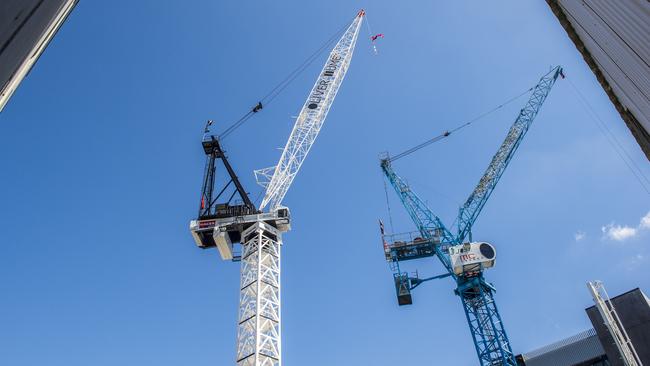Australia’s GDP increased 0.5pc in June quarter, up 3.3pc from year earlier
Australia’s marked 25 years without a recession, with rising government spending aiding 3.3pc growth in the year to June.

Australia has marked 25 years without a recession with annual growth rising at its fastest clip in four years.
Official numbers from the Australian Bureau of Statistics revealed seasonally adjusted GDP growth of 0.5 per cent for the second quarter and 3.3 per cent for the 12 months to June 30.
This was broadly in line with market expectations due to an uptick in government expenditure, although the quarterly number slowed sharply from March’s downwardly revised 1 per cent jump.
The Australian economy has now expanded for 21 straight quarters and the nation has not seen a recession since 1991, the second longest streak in the developed world.
“It’s official, Australia has now achieved 25 years of uninterrupted economic expansion,” said Treasurer Scott Morrison. “But it is no time for complacency. We continue to fight for every inch of growth in a very challenging world economy.”
The Australian dollar edged down on the data, slipping 0.1 of a cent to US76.6c at 11.35am (AEST) but largely clung to gains realised overnight as soft US data raised doubts about an imminent US rate hike.
The quarterly advance was driven by household and public consumption spending as domestic final demand lifted 0.6 per cent.
Total investment for the June quarter was flat, with the tailing off in the mining investment boom offset by growth in government spending.
The stunning March quarter number had been driven by exports as commodity prices rose off lows and mining production lifted.
The same impact was not seen through the June quarter, with the ABS noting international trade detracted from growth due to rising imports and a slowdown in export growth.
“After strong growth in the March quarter, production in the mining industry was lower in seasonally adjusted terms in the June quarter,” the official government statistics body said.
Capital Economics chief Australian economist Paul Dales said the result was a good one given the strong marker set in the prior quarter.
“The return of the Australian economy in the second quarter to the growth rates seen before the end of the mining boom relieves some of the pressure on the RBA to cut interest rates again, at least in the next few months,” he said.
However, a slowdown in personal consumption growth was seen as a concerning sign, as government infrastructure spending carried the domestic demand load.
“Most worryingly, consumption growth slowed from 0.8 per cent quarter-on-quarter in the first quarter to just 0.4 per cent in the second. That’s the smallest increase in three years and suggests that the record low rates of wage growth are starting to bite,” he said.
“Thankfully, though, the government has come to the rescue. Government consumption rose by 1.9 per cent quarter-on-quarter and public investment increased by 15.5 per cent.”
Mr Dales added the result offered a hint of “secret fiscal stimulus” as the public sector added one percentage point to the quarterly rate of growth, from just 0.3 percentage points in the March quarter.
NAB head of Australian economics Riki Polygenis also noted the details of the release were “mixed” outside strength in government spending.
“The recovery in the non-mining economy continued, although did lose some momentum in the second quarter — our estimates of non-mining GDP increased by 0.7 per cent in the quarter and eased slightly to 3.1 per cent in year-ended terms from almost 4 per cent year-on-year in the second quarter,” she said.
“Industry gross value added data show that real estate services, finance, wholesale and ICT all outperformed.
“On the other hand, agriculture and manufacturing continued to struggle while construction was weak too.”
In trend terms, growth was pegged at 3.1 per cent for the year, driven by the ongoing transition from mining investment to production, with mining adding 0.8 percentage points to the number. Mining led the way among the nation’s most significant sectors, ahead of the finance sector (+0.5 percentage points), in a strikingly similar showing to the prior quarter.
Public administration and safety, construction and wholesale trade also contributed to the positive figures, while manufacturing was again the primary detractor in pulling back 0.2 percentage points for the second straight quarter.
The steady GDP numbers follow a decision from the Reserve Bank to keep rates on hold at its September board meeting yesterday, after two rate cuts through May and August.
Ahead of the figures, futures markets had priced in a 38 per cent chance of a further reduction in rates before year’s end, with this number inching up to 38.5 per cent on this morning’s data.
“The influence these figures have on the outlook for the economy and monetary policy will depend on whether the support to growth from government spending continues,” NAB’s Ms Polygenis said.
“We do not expect any near-term shift in monetary policy, but retain our view that two cuts will follow in mid-2017 in response to the ongoing weak inflation and risk that the economy slows too sharply in 2018 as the dwelling construction cycle ends and LNG exports flatten off.”




